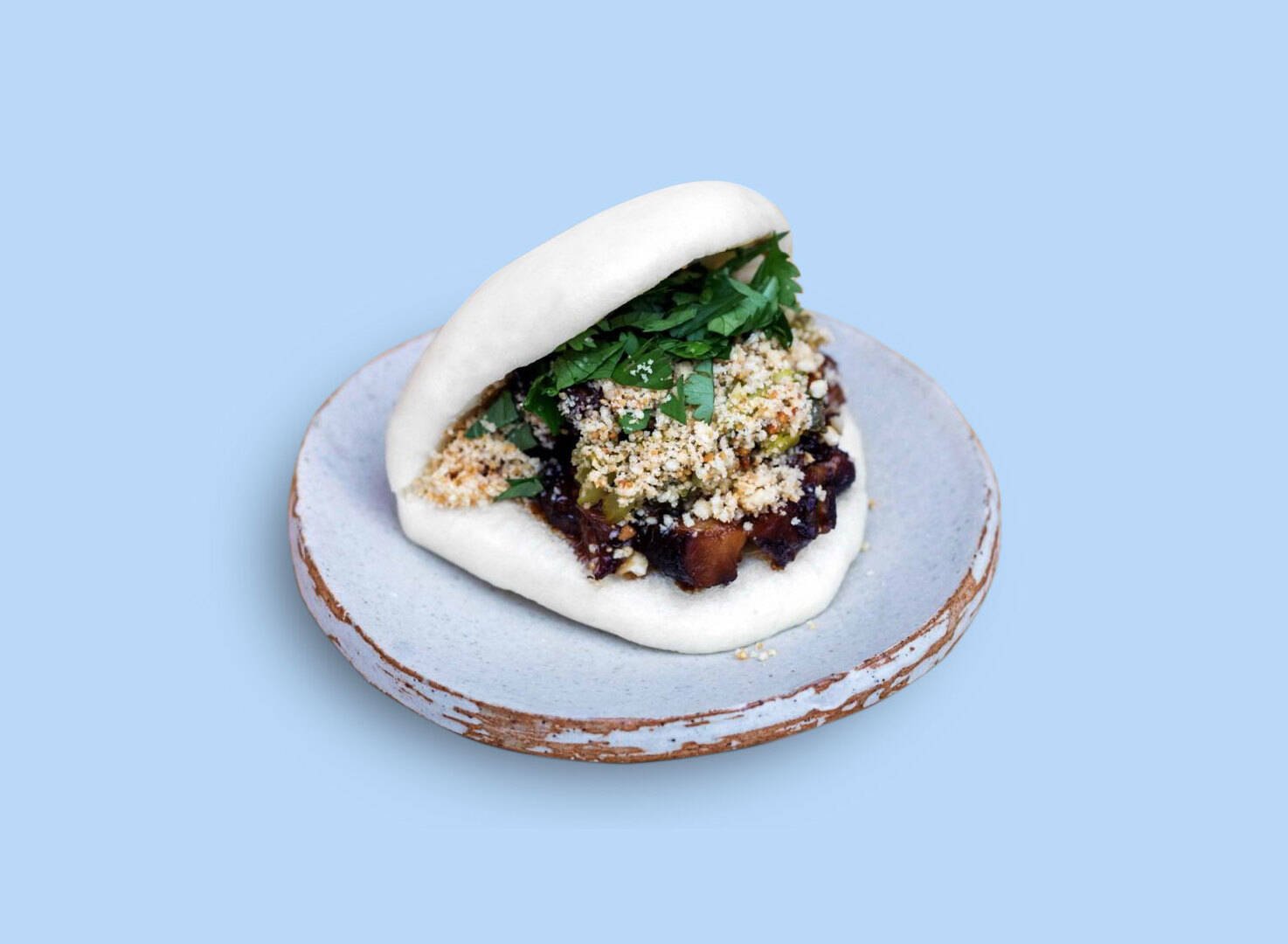Sometimes delicious doesn't take much
familiar and comforting to create something that is both at the same time. In the words of Douglas Adams, you’re making something almost, but not quite, entirely unlike tea.
eliciousness then, is in using food to create a paradox of taste. It is about merging the new and unexpected with the
d

By sight alone, you would never be able to tell the patty itself isn’t meat. But when you take a bite, it surprises. It has the heft, the tenderness, and even some of the texture of meat, but there is no umami explosion. Instead, your mouth is filled with taste of beans, roasted nuts, and cereal. It’s so close, yet so far at the same time. The discordant sensations demand your full attention. You start to think about what you’re eating. Despite your best intentions, it’s not quite what you expected it to be. Simply put, it’s delicious.
New York is one such place. Their namesake burger costs $6 and their simplicity follows the exact same base principles as Noma’s extravagance. The burger isn’t a burger at all. It’s completely vegetarian, but made to resemble meat in all the ways that matter. When you eat it, you are vividly reminded of all those times you ate your favorite burger, while at the same time being aware that what you’re eating isn’t meat. The bun is a potato roll, making it ever so slightly softer than a full wheat bun. The toppings are carefully traditional: velvety melted cheese, crunchy iceberg lettuce, juicy roasted tomatoes, pickles and honey mustard.
roof that delicious food doesn’t have to cost $600 dollars a meal can be found nearly everywhere. Superiority burger in
p

Few things are as craveable as a burger
Writing for Esquire, Kevin Sintumuang says ‘the food felt alien and familiar all at once.’ So when they serve you a single, perfectly ripe piece of cacao fruit, beautiful for its succulent, pearlescent simplicity, it is delicious because the unassuming exterior and the suggestion of chocolate find themselves in conflict with the complex flavors reminiscent of lychee and vanilla. And when you are confronted with a miniature banana gently covered with seaweed oil and a paste made from the charred peel of the very same banana, your mind is captivated by a depth of flavor that you weren’t aware a banana could ever have. This is food that is transformative, arguably transcendent, but it doesn’t have to be this intricate.
Jonathan Gold of the LA Times
‘Flavors as familiar as childhood and as old as time, transformed or detransformed.’
Eating at Noma Mexico may just be the meal of the decade. But why? Is it just that they’re making delicious food? They’re hardly the only ones to do that. Granted, Redzepi and his team have created an often imitated but never duplicated style of cooking that makes them arguably the best in the world, but their goal is the same. The reaction they want their diners to have doesn’t change. Tom Sietsema of the Washington Post says of Noma: ‘This is food that makes you laugh and think and brace yourself for the next course.’
ake, for example, chef René Redzepi’s recent venture: Noma Mexico. The critics are ecstatic, the reviews superlative.
T
grand theory have any practical applications? The answer is of course, yes, if you’re willing to look below the surface.
ll of that is well and good, but it’s – as Chang himself acknowledges – a bit of an intellectual exercise. Does this
A
Noma Mexico created delicious works of art

The key then, isn’t to aim for anything specific, but rather for a general association. The best way to do that is by deconstructing a dish down to its component flavors, textures, and aromas, and using those to create something that is both new and intimately familiar.
Every time you eat something, some part of you is transported back to another time, another meal.
sounds, because it really doesn’t take much to trigger a memory with food.
he second quality that makes up a delicious dish is that it evokes memory. This is actually easier to achieve than it
T
Momofuku made the pork bun famous
captures your absolute, undivided attention. A delicious dish is a literal conversation stopper. The best way to demand that kind of attention is by hitting the perfect sweet spot of flavor. It’s a place where your dish is too salty and not salty enough at the same time. It’s a place best found through relentless trial and error. If you hit it, you’ll know, because you’ll stop to think about what you’re tasting. That’s what you’re after, that moment of complete, undivided attention.
truly, earthshattering, memorable dish has a few requirements. The most important of which is that it
A

Text: Jelle Steenbergen | Music: Laura Brehm - Cosmic Gravity
Momofuku founder David Chang believes he has cracked the code. He has formulated what he calls the Unified Theory of Deliciousness. He has figured out how to make mouths water and grown men cry.
he most important thing about food is that it tastes good. Easier said than done, of course, but celebrity chef and
t
deliciousness
g
n
i
D
o
C
e
D

eliciousness then, is in using food to create a paradox of taste. It is about
merging the new and unexpected with the familiar and comforting to create something that is both at the same time. In the words of Douglas Adams, you’re making something almost, but not quite, entirely unlike tea.
d

By sight alone, you would never be able to tell the patty itself isn’t meat. But when you take a bite, it surprises. It has the heft, the tenderness, and even some of the texture of meat, but there is no umami explosion. Instead, your mouth is filled with taste of beans, roasted nuts, and cereal. It’s so close, yet so far at the same time. The discordant sensations demand your full attention. You start to think about what you’re eating. Despite your best intentions, it’s not quite what you expected it to be. Simply put, it’s delicious.
nearly everywhere. Superiority burger in New York is one such place. Their namesake burger costs $6 and their simplicity follows the exact same base principles as Noma’s extravagance. The burger isn’t a burger at all. It’s completely vegetarian, but made to resemble meat in all the ways that matter. When you eat it, you are vividly reminded of all those times you ate your favorite burger, while at the same time being aware that what you’re eating isn’t meat. The bun is a potato roll, making it ever so slightly softer than a full wheat bun. The toppings are carefully traditional: velvety melted cheese, crunchy iceberg lettuce, juicy roasted tomatoes, pickles and honey mustard.
roof that delicious food doesn’t have to cost $600 dollars a meal can be found
p

Writing for Esquire, Kevin Sintumuang says ‘the food felt alien and familiar all at once.’ So when they serve you a single, perfectly ripe piece of cacao fruit, beautiful for its succulent, pearlescent simplicity, it is delicious because the unassuming exterior and the suggestion of chocolate find themselves in conflict with the complex flavors reminiscent of lychee and vanilla. And when you are confronted with a miniature banana gently covered with seaweed oil and a paste made from the charred peel of the very same banana, your mind is captivated by a depth of flavor that you weren’t aware a banana could ever have. This is food that is transformative, arguably transcendent, but it doesn’t have to be this intricate.
Jonathan Gold of the LA Times
‘Flavors as familiar as childhood and as old as time, transformed or detransformed.’
critics are ecstatic, the reviews superlative. Eating at Noma Mexico may just be the meal of the decade. But why? Is it just that they’re making delicious food? They’re hardly the only ones to do that. Granted, Redzepi and his team have created an often imitated but never duplicated style of cooking that makes them arguably the best in the world, but their goal is the same. The reaction they want their diners to have doesn’t change. Tom Sietsema of the Washington Post says of Noma: ‘This is food that makes you laugh and think and brace yourself for the next course.’
ake, for example, chef René Redzepi’s recent venture: Noma Mexico. The
T
an intellectual exercise. Does this grand theory have any practical applications? The answer is of course, yes, if you’re willing to look below the surface.
ll of that is well and good, but it’s – as Chang himself acknowledges – a bit of
A
The key then, isn’t to aim for anything specific, but rather for a general association. The best way to do that is by deconstructing a dish down to its component flavors, textures, and aromas, and using those to create something that is both new and intimately familiar.

Every time you eat something, some part of you is transported back to another time, another meal.
This is actually easier to achieve than it sounds, because it really doesn’t take much to trigger a memory with food.
he second quality that makes up a delicious dish is that it evokes memory.
T
important of which is that it captures your absolute, undivided attention. A delicious dish is a literal conversation stopper. The best way to demand that kind of attention is by hitting the perfect sweet spot of flavor. It’s a place where your dish is too salty and not salty enough at the same time. It’s a place best found through relentless trial and error. If you hit it, you’ll know, because you’ll stop to think about what you’re tasting. That’s what you’re after, that moment of complete, undivided attention.
truly, earthshattering, memorable dish has a few requirements. The most

A
Text: Jelle Steenbergen
done, of course, but celebrity chef and Momofuku founder David Chang believes he has cracked the code. He has formulated what he calls the Unified Theory of Deliciousness. He has figured out how to make mouths water and grown men cry.
he most important thing about food is that it tastes good. Easier said than
t
g
n
i
D
o
C
e
D
deliciousness
